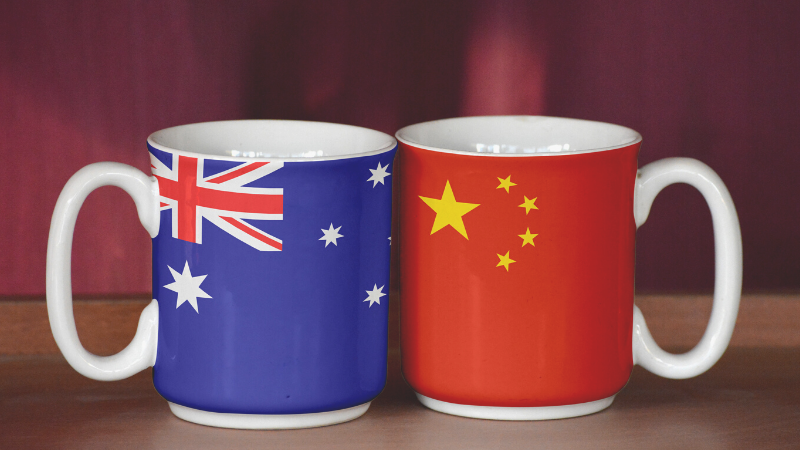Perspectives | Remembering and misremembering Whitlam’s PRC policy
December 05 2022

Perspectives is UTS:ACRI's commentary series, featuring a piece on a topical subject in the Australia-China relationship from an invited expert contributor.
By James Curran
When Foreign Minister Penny Wong delivered the Whitlam Oration at Blacktown’s Bowman Hall last month, it was inevitable that the historical threads between the early 1970s and today would be drawn. The site is, after all, steeped in Labor lore and legend: the place where Gough Whitlam launched the successful 1972 ‘It’s Time’ campaign. For the true believers, it rarely gets more dewy-eyed than this.
Wong did not disappoint the Labor faithful. Her speech, in effect a rhetorical capstone to the Albanese government’s first half-year directing Australian foreign policy, stressed Whitlam’s role in presenting what he called a ‘clean face’ to the region: a nation shedding its White Australia tag and connecting the treatment of its indigenous peoples to the very question of its acceptance in a rapidly changing Asia.
Having herself shuttled almost ceaselessly to and from countries in the Pacific and Southeast Asia in recent months, extolling Canberra’s commitment to ASEAN centrality, projecting Australia’s ‘full identity’ and proclaiming a commitment to a ‘First Nations’ foreign policy, the inspirational impulse of the minister’s approach was clear.
The Foreign Minister knows, too, that just as in the 1970s, a Labor government has taken office in the wake of a period where its political opponents sought to make the People’s Republic of China (PRC) an issue of crude domestic advantage.
Just over half a century ago, that stance had blown up in former prime minister’s Billy McMahon’s face when Whitlam, in a masterstroke, boldly visited the PRC as opposition leader in 1971, just days – so it turned out – before Henry Kissinger also arrived to lay the foundations for President Richard Nixon’s ground-breaking visit in 1972.
Understandably enough, Wong relished telling that story in her speech, not missing the chance to bequeath the McMahon legacy to former prime minister Scott Morrison and defence minister Peter Dutton. They too, she said witheringly, had ‘put party over country’.
But that was where the historical comparisons on the PRC ended. In a thoughtful address, her speech also trod carefully around the Whitlam legend. The circumstances between then and now, particularly in relation to the PRC’s position in the world, are vast and all consuming.
Above all, the Foreign Minister was not going to hold a Whitlamesque séance in an effort to divine what his policy would be today. ‘We ultimately cannot be sure’, she said, ‘what Gough would do if he faced our present circumstances’.
In the light of the meeting that took place between Prime Minister Anthony Albanese and PRC President Xi Jinping in Bali only days after this address, Wong’s consistent message about ‘stabilising’ the relationship with Beijing clearly bore its first fruit in the form of a resumption of dialogue at the highest levels. That, of course, is only a start, since as Wong stressed, even stabilisation will ‘take time because our differences are not trivial’.
That part of the speech drew praise from The Australian’s foreign editor, Greg Sheridan. He labelled it a ‘masterpiece in leading Labor true believers to sensible policy’ on the PRC.
But Sheridan also pointed that Wong did not offer a ‘balanced assessment’ of Whitlam’s foreign policy record. The sins of omission were, inter alia, the loans affair, his statement of contempt for Vietnamese refugees and his position on Taiwan.
Yet, as Sheridan knows, few Liberal foreign ministers rarely discuss Menzies’ initial, near contemptuous dismissal of Percy Spender’s ambitions for the ANZUS treaty in 1951 – an attempt ‘to erect a superstructure on a foundation of jelly,’ Menzies quipped – his disastrous support for Britain during the 1956 Suez crisis, and his tenacious defence of the White Australia policy, the principles of which he told Cabinet in 1964 constituted the ‘right sort of discrimination’.
The Sheridan critique of Whitlam’s approach to China, however, went further. He argued that it was ‘almost universally damaging in Australian policy’, that Whitlam had ‘idealised’ and ‘romanticised’ the relationship with Beijing and moreover that he had created a ‘destructive dynamic within Labor that considered any disagreement with Beijing to be a sign of failed Australian policy’.
The critique is important since it provides a window onto a persistent feature of the Australian PRC debate since late 2016: its tendency to render much of the history of the relationship in caricature. Here the history of the relationship becomes an unending stream of leaders and officials being duped by Beijing, captivated by the PRC market and in the process leaving the country virtually defenceless at the moment Xi Jinping comes to power and flexes the PRC’s strategic muscle.
But this is fundamentally at odds with the historical record. As I have shown in my recent book, Australia’s China Odyssey (NewSouth, 2022), from its very foundation voices of doubt and anxiety over China’s intentions and long-term trajectory were as much a feature of the relationship as were those of euphoria and excitement.
And that is true, too, of the Whitlam years. Sure, Whitlam said he wanted a relationship with the PRC ‘comparable’ to what Australia had with other major powers, but he was neither unthinking nor naive about the risks involved. There were limits being aired about the possibilities for Australia’s relationship with the PRC – even in 1973.
When in April that year Whitlam set out for Australia’s first ambassador to the PRC, Stephen FitzGerald, the task ahead in founding the mission in Beijing and managing the early years of the relationship, he stressed that the PRC would not be the ‘central preoccupation of our foreign policy’. Australia was ‘not in any sense ‘committed to China’, or willing to give China uncritical support’, a point Whitlam made explicitly to PRC Premier Zhou Enlai on his visit to Beijing as Prime Minister later in 1973.
Nor was the relationship to come at the expense of ties to the US, Indonesia, Japan and Southeast Asia. He did not want it to ‘unnecessarily disturb’ the relationship with Washington. And the path ahead would be tricky: Australia, Whitlam conceded, might not ‘achieve as much as we would wish as quickly as we would wish’.
It is true that on Taiwan Whitlam underlined to FitzGerald an essential difference between Australian and American policy. The US, Whitlam wrote, ‘retains links with Taiwan which impose obligations on it but which we have altogether abandoned’. But he nevertheless instructed the new envoy to report as fully as possible on ‘any indications of Chinese attitudes towards Taiwan’. He wrote:
Present Chinese thinking appears to be against armed action and in favour of liberation by ‘people’s diplomacy’. We hope that this policy will continue and be successful. In the meantime, we intend to be quite firm in insisting that private trade and travel between Australia and Taiwan should continue… we have nothing against the people of Taiwan.
Crucially, Australia could not afford to sow suspicion in Beijing about its motives for seeking a new relationship, nor could it give the impression that Canberra was ‘careless of our own interests’.
This very task was given something of Homeric proportions. ‘They themselves are hard-headed realists,’ Whitlam reminded Fitzgerald of the Chinese, ‘and it would be unnatural of them not to take advantage of us or hold us in contempt for apparent weakness’.
Nevertheless, Whitlam was confident that his new envoy could ‘steer a course between the Scylla of unnecessary suspicion, on the one hand, and the Charybdis of apparent carelessness, on the other’.
Whitlam was setting out the challenge of Australia’s relations with the PRC for succeeding generations. He was stretching out the tightrope across which future governments would traverse. The story in Australia’s China Odyssey is, in essence, an account of how governments since the 1970s have managed that path across the policy highwire.
In her oration, Wong also stressed that Whitlam’s China breakthrough was part of a broader policy of regional engagement. It was not a PRC-only policy, for after his visit to Beijing in 1971 Whitlam had also visited Japan and the Philippines.
Moreover, as Wong put it, Whitlam ‘understood the reality that we can’t only engage with those who share our values, whether on human rights or anything else’. That is a position Whitlam had stressed from his very first speeches to the parliament on international affairs in the 1950s.
It is worth recalling – particularly at a time when the PRC challenge looms large – that Whitlam never bought into the image of the PRC as a coiled spring waiting to pounce on a vulnerable Australia. Yes, it is a different world and a different PRC today under Xi Jinping. Still, the point remains: Whitlam had the intellectual courage to challenge deep-seated assumptions.
There is much to be said, then, for the Foreign Minister’s commitment to navigate the differences with the PRC ‘wisely’. She hopes Beijing will do the same.
James Curran is Professor of Modern History at Sydney University, Australian Financial Review foreign affairs columnist and author of Australia’s China Odyssey (NewSouth, 2022).

